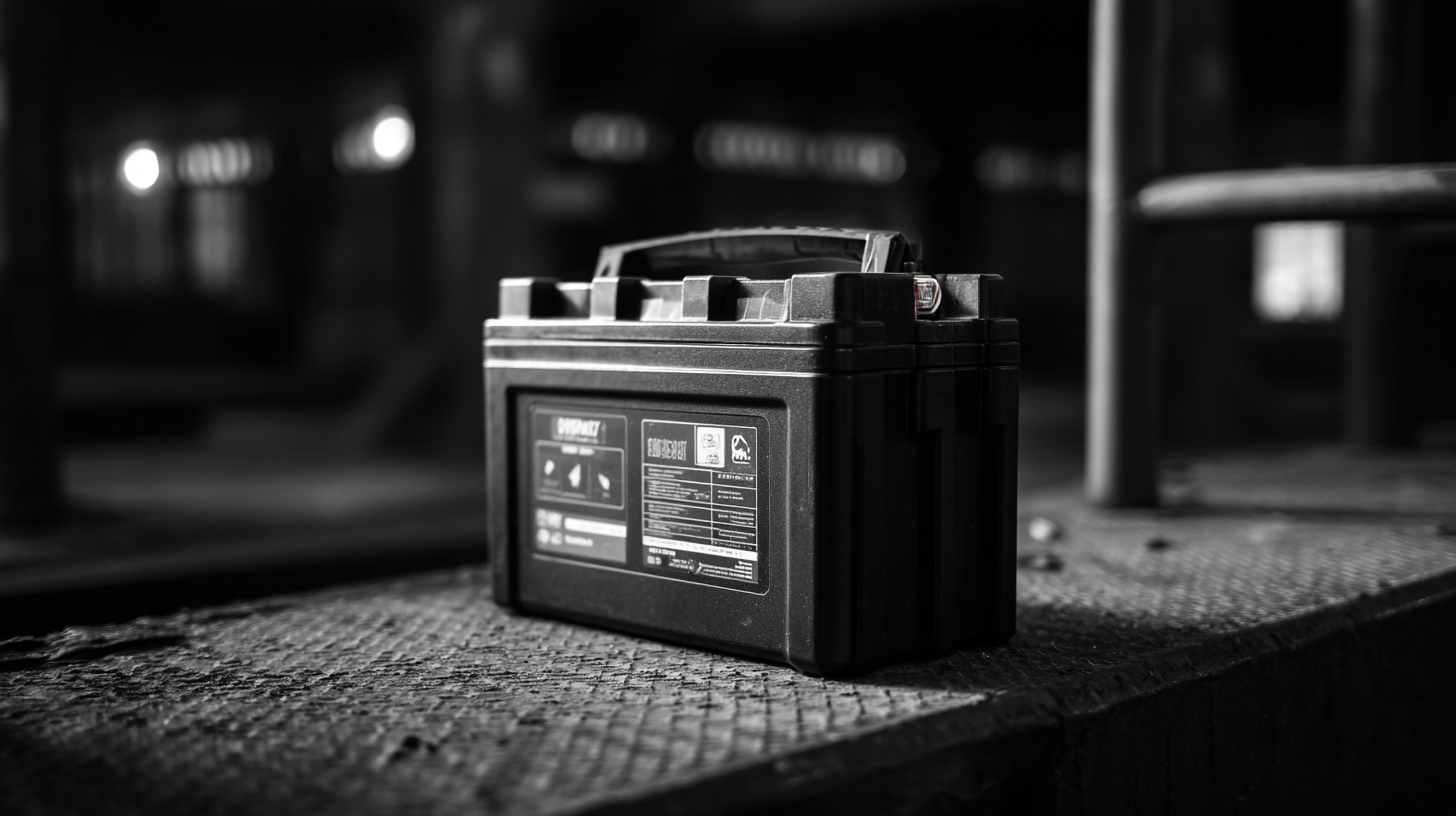Innovative Solutions for Emergency Light Battery Maintenance You Should Know
In an era where safety and preparedness are paramount, the effective maintenance of emergency light batteries has come to the forefront of emergency response strategies. According to a report by the National Fire Protection Association (NFPA), roughly 20% of commercial building fires involve the failure of emergency lighting systems due to inadequate battery maintenance. This statistic underscores the critical need for innovative approaches to ensuring that emergency light batteries remain operational when they are most needed.

Moreover, as technology continues to evolve, traditional battery maintenance practices must be re-evaluated to incorporate advanced solutions that enhance reliability. A comprehensive analysis by the International Emergency Light Association indicates that battery failure can compromise emergency lighting by up to 70%, highlighting the importance of regular maintenance and innovative management techniques.
By integrating smart technology and automated monitoring systems, facility managers can significantly reduce the risk associated with emergency light battery failure, ensuring a safer environment for all. This article will explore effective maintenance strategies and innovative solutions that can transform the way we approach emergency light battery upkeep.
Innovative Battery Management Systems Enhancing Emergency Light Performance
In the realm of emergency lighting, innovative battery management systems (BMS) play a critical role in enhancing performance and reliability. These advanced systems are designed to monitor and control battery usage, ensuring that emergency lights remain operational when needed most. With real-time data collection and analysis, BMS can identify potential issues before they lead to failure, thus prolonging the lifespan of the battery. This proactive approach not only helps in maintaining the lights but also provides peace of mind for users who depend on these systems during power outages.
Additionally, modern BMS are equipped with features that enable intelligent charging, which optimizes the charging cycles of the batteries. By adapting the charge based on the specific needs of the battery, these systems can prevent overcharging and deep discharging, two common factors that compromise battery health. Furthermore, certain BMS technologies incorporate wireless connectivity, allowing for remote monitoring and updates. This capability enables facility managers to maintain oversight without the need for constant physical checks, ultimately streamlining maintenance processes and ensuring that emergency lights are always ready for action.
Periodic Maintenance Protocols: Extending Battery Lifespan and Reliability
Periodic maintenance of emergency light batteries is crucial for extending their lifespan and ensuring reliability. Implementing structured protocols can significantly enhance battery performance by identifying potential issues before they lead to failure. Regular inspections and testing can help monitor battery health, optimizing charging cycles and ensuring that batteries are not overworked. This proactive approach not only prolongs battery life but also enhances the safety of emergency lighting systems.
Advancements in technology, particularly artificial intelligence and machine learning, are transforming how we approach battery maintenance. These technologies can analyze large datasets to predict when maintenance is needed, reducing downtime and preventing unexpected failures. Moreover, remote battery monitoring systems are emerging as essential tools for energy storage management. By continuously tracking battery performance, they provide real-time insights that enable timely interventions, ensuring that batteries operate efficiently and safely throughout their lifecycle. Implementing these innovative solutions can lead to significant improvements in the maintenance and reliability of emergency light battery systems.
Innovative Solutions for Emergency Light Battery Maintenance You Should Know
| Maintenance Protocol | Frequency | Tools Required | Estimated Time | Expected Lifespan Increase |
|---|---|---|---|---|
| Visual Inspection | Monthly | None | 10 mins | 6 months |
| Battery Testing | Quarterly | Multimeter | 15 mins | 1 year |
| Battery Cleaning | Biannually | Cleaning solution, cloth | 20 mins | 8 months |
| Battery Replacement | Every 3 years | Screwdriver | 30 mins | 3 years |
| System Upgrade | As needed | None | Variable | Variable |
Revolutionary Charging Techniques: Fast Charging Solutions for Emergency Lights
Revolutionary charging techniques are transforming the landscape of emergency light battery maintenance, offering fast and efficient solutions that enhance reliability in critical situations. According to a recent report by MarketsandMarkets, the global emergency lighting market is projected to grow at a CAGR of 7.2% from 2021 to 2026, driven in part by advances in battery technology and charging methodologies. Fast charging solutions, such as ultracapacitors and smart charging systems, are leading the charge in this transformation, allowing for up to 80% charge in just 10 minutes, significantly reducing downtime and ensuring emergency lights are always ready when needed.

Furthermore, the adoption of solar charging technologies is making waves in the emergency lighting sector. A study by the International Energy Agency indicates that solar-powered emergency lights can reduce operational costs by about 30%, while also promoting sustainability. These technologies utilize advanced photovoltaic cells that convert sunlight into energy efficiently, enabling prolonged battery life and quicker recharging cycles. This shift not only enhances the performance of emergency lights but also aligns with global efforts to reduce carbon footprints, making modern emergency lighting systems smarter and more environmentally friendly than ever before.
Data-Driven Monitoring: Using IoT for Real-Time Battery Health Assessment
The importance of reliable emergency lighting cannot be overstated, particularly in crisis situations where safety is paramount. To ensure that these systems function effectively, battery maintenance emerges as a crucial component. Embracing data-driven monitoring through the Internet of Things (IoT) allows facility managers to leverage real-time battery health assessments. According to a report by MarketsandMarkets, the global IoT market in the energy sector is projected to reach $62.4 billion by 2026, illustrating an accelerating trend toward smart maintenance solutions.
Integrating IoT technology into battery management enables continuous monitoring of voltage, temperature, and charge cycles. For instance, real-time analytics can predict potential failures and provide alerts when a battery's performance dips below optimal levels. A study published in the Journal of Energy Storage highlighted that predictive maintenance through IoT can reduce operational costs by up to 30% by minimizing unexpected downtimes and enhancing battery lifecycle management. Implementing these innovative solutions not only safeguards emergency lighting systems but also promotes a proactive approach to maintenance that ultimately contributes to operational efficiency and safety compliance.
Sustainable Practices: Eco-Friendly Approaches to Battery Disposal and Recycling
When it comes to emergency light battery maintenance, sustainable practices are becoming increasingly essential. As awareness grows around the environmental impact of battery disposal, adopting eco-friendly approaches is crucial. One of the most significant steps in sustainability is responsibly recycling batteries. Many local recycling centers can handle batteries, ensuring that hazardous materials are disposed of safely and that valuable materials are repurposed.

**Tips**: Always check for recycling programs in your area. Many manufacturers and retailers offer take-back programs for used batteries, making it convenient to dispose of them properly.
Additionally, consider investing in rechargeable batteries for your emergency lights. Not only do they reduce waste, but they also offer a cost-effective solution over time. When these batteries reach the end of their life cycle, be sure to dispose of them in a way that minimizes environmental impact.
Tips: Look for battery technologies with environmental certifications. This helps ensure that when it’s time to dispose of them, the process aligns with sustainable practices.
Related Posts
-

Transform Your Yard: The Ultimate Guide to Choosing the Right Lawn Battery for Your Needs
-

Exploring the Future of Battery Technology Innovations Strategies to Enhance Performance and Sustainability
-

Unlocking the Future of Energy Storage Innovations with 12 Battery at the 2025 China Import and Export Fair
-

Batteries Delivered Revolutionizing Supply Chains at the 138th China Import and Export Fair 2025
-

Exploring the Benefits and Applications of Sealed Lead Acid Batteries in Modern Technology
-

Unveiling Battery Acid Innovations at the 2025 China Import and Export Fair
